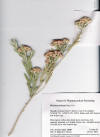|
Pluchea sericea |
|
|
Trees and Shrubs of Kern County (Sep 2012) Pluchea sericea (Polypappus sericeus Nuttall 1848) Coville 1893. Arrow weed. Tall shrub, somewhat willow-like, to 5 m, with numerous erect densely leafy stems; leaves silvery silky, narrow elliptical, 2.5–3.5 × times longer than wide, 1–4.5 cm long, down- curved along the blade, midnerve prominent. Flowering almost any time of the year, primarily May–Jun; flower heads short peduncled, 3–8 clustered near ends of leafy branchlets, inverted triangular in outline, involucral bracts pink to purplish in ~4 imbricate ranks, nearly elliptical, slightly wider below mid region; flowers pink to rose, as many as 28 per head; cypselae with a relatively short subcylindric 4-angled pericarpium, 0.5 mm, and long terminal capillary bristles, to 5 cm, the bristles dilated near apex Along margins of wet places, or sand hummocks near saline lake beds, which may be periodically wet, below 3,600 ft; Utah to southwestern Texas, Chihuahua, Sonora, Arizona, southern California, and Baja California to the Vizcaíno Peninsula. Arrow weed thickets recognized in MCV2 when ≥2% absolute cover and not exceeded in such over by other species. Type from California. Kern Co.: “Caliente Canyon flood plain at the west end of Sand Ridge, along Kern River east and west of Hart Park, and in Grapevine Canyon in the Sierra Nevada north of Walker Pass” (Twisselmann); also El Paso Mts., Mesquite Springs, north of Fremont Valley and south of Ridgecrest, 2,200ft (CCH: D. Charlton, Dec 1989 & Apr 1990). Roots and bark used medicinally by the Havasupai, Paiute, and Pima tribes for treating diarrhea, sore eyes, and stomachaches, and also for snakebites (Moerman).
References on Pharmacological Activity in Pluchea Biswas R., P. K. Dutta, B. Achari, D. Bandyopadhyay, M. Mishra, K. C. Pramanik and T. K. Chatterjee. 2007. Isolation of pure compound R/J/3 from Pluchea indica (L.) Less. and its anti-amoebic activities against Entamoeba histolytica. Phytomedicine 14(7-8): 534–537. “The plant Pluchea indica is known for its anti-inflammatory, anti-ulcer, anti-pyretic, hypoglycemic, diuretic and anti-microbial activities besides many other pharmacological activities. We have isolated and purified seven compounds from the methanolic root extract of this plant by column chromatography. The compounds were identified by spectroscopic analyses. The anti-amoebic activities of the pure compound R/J/3 was investigated against the HM1 strain of Entamoeba histolytica. The compound, R/J/3 showed the most pronounced anti-proliferative activity at a dose of 50 microg/ml. It also showed a marked activity on cell lysis of trophozoites, 4h after administration. The cell lytic activity was compared with metronidazole (5 microg/ml) as positive control.” Gomes A., A. Saha, I. Chatterjee and A. K. Chakravarty. 2007. Viper and cobra venom neutralization by beta-sitosterol and stigmasterol isolated from the root extract of Pluchea indica Less. (Asteraceae). Phytomedicine. 14(9): 637–643. “We reported previously that the methanolic root extract of the Indian medicinal plant Pluchea indica Less. (Asteraceae) could neutralize viper venom-induced action [Alam, M.I., Auddy, B., Gomes, A., 1996. Viper venom neutralization by Indian medicinal plant (Hemidesmus indicus and P. indica) root extracts. Phytother. Res. 10, 58-61]. The present study reports the neutralization of viper and cobra venom by beta-sitosterol and stigmasterol isolated from the root extract of P. indica Less. (Asteraceae). The active fraction (containing the major compound beta-sitosterol and the minor compound stigmasterol) was isolated and purified by silica gel column chromatography and the structure was determined using spectroscopic analysis (EIMS, (1)H NMR, (13)C NMR). Anti-snake venom activity was studied in experimental animals. The active fraction was found to significantly neutralize viper venom-induced lethal, hemorrhagic, defibrinogenation, edema and PLA(2) activity. Cobra venom-induced lethality, cardiotoxicity, neurotoxicity, respiratory changes and PLA(2) activity were also antagonized by the active component. It potentiated commercial snake venom antiserum action against venom-induced lethality in male albino mice. The active fraction could antagonize venom-induced changes in lipid peroxidation and superoxide dismutase activity. This study suggests that beta-sitosterol and stigmasterol may play an important role, along with antiserum, in neutralizing snake venom-induced actions.” |
|
